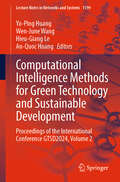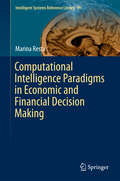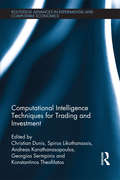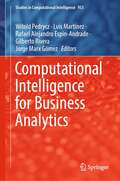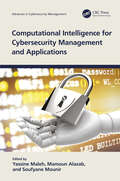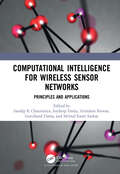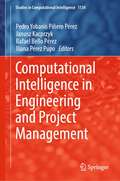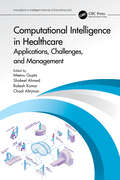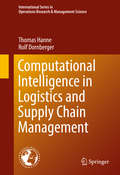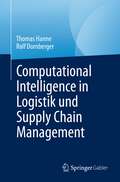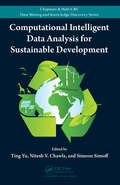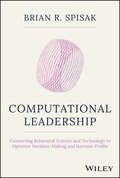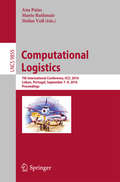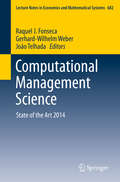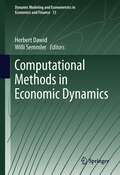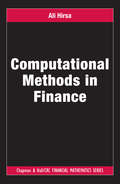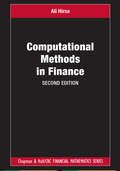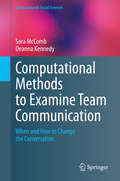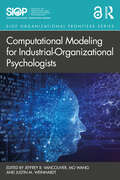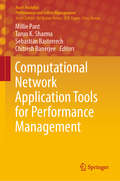- Table View
- List View
Computational Intelligence Methods for Green Technology and Sustainable Development: Proceedings of the International Conference GTSD2022 (Lecture Notes in Networks and Systems #567)
by Yo-Ping Huang Wen-June Wang Hoang An Quoc Hieu-Giang Le Hoai-Nam QuachThis book provides readers with peer-reviewed research papers presented at the 6th International Conference on Green Technology and Sustainable Development (GTSD) held in Nha Trang City, Vietnam, from July 29 to 30, 2022. The book is original work of researchers from academia and industry focusing on the theme “Green technology and sustainable development in Industrial Revolution 4.0” not only to raise awareness of the vital importance of sustainability in education, technology, and economic development, but also to highlight the essential roles of technology innovation for the green future. The book presents a wide range of research aspects including energy engineering, electric power systems, renewable energy systems, automatic control engineering, robotics, vehicle engineering, material engineering, construction engineering, mechanical engineering, vibrations, computational analysis, numerical investigation, system failure, technological solutions in health care, and so on. Through thorough research basing on both experimental and numerical methods, the authors feature either solutions for existing problems or optimization and improvement for performance of existing methods. The collected research results could be useful alternatives and implications for industry experts, research institutions, universities, and all others who share a common interest in the future global sustainable development.
Computational Intelligence Methods for Green Technology and Sustainable Development: Proceedings of the International Conference GTSD2024, Volume 1 (Lecture Notes in Networks and Systems #1195)
by Yo-Ping Huang Wen-June Wang Hieu-Giang Le An-Quoc HoangThis book is presented in two volumes, featuring peer-reviewed research papers from the 7th International Conference on Green Technology and Sustainable Development (GTSD), held in Ho Chi Minh City, Vietnam, from July 25 to 26, 2024. It highlights original research by experts from both academia and industry, centered on the theme of "Green Technology and Sustainable Development in the Industrial Revolution 4.0." The book underscores the critical importance of sustainability in education, technology, and economic development, while also showcasing the vital role of technological innovation in creating a greener future. The papers documented in this book cover a broad range of topics, including renewable energy systems, smart grids, artificial intelligence, robotics and intelligent systems, and computational intelligence, all with a focus on sustainable development, climate change mitigation, and environmental policy. These studies showcase cutting-edge technologies and innovative ideas related to green technology, offering actionable insights for advancing sustainable development across various sectors. The authors present research based on both experimental and numerical methods, offering solutions to current problems and optimizing existing methods. The insights and findings provided are valuable for industry experts, research institutions, universities, and anyone interested in advancing global sustainable development.
Computational Intelligence Methods for Green Technology and Sustainable Development: Proceedings of the International Conference GTSD2024, Volume 2 (Lecture Notes in Networks and Systems #1199)
by Yo-Ping Huang Wen-June Wang Hieu-Giang Le An-Quoc HoangThis book is presented in two volumes, featuring peer-reviewed research papers from the 7th International Conference on Green Technology and Sustainable Development (GTSD), held in Ho Chi Minh City, Vietnam, from July 25 to 26, 2024. It highlights original research by experts from both academia and industry, centered on the theme of "Green Technology and Sustainable Development in the Industrial Revolution 4.0." The book underscores the critical importance of sustainability in education, technology, and economic development, while also showcasing the vital role of technological innovation in creating a greener future. The papers documented in this book cover a broad range of topics, including renewable energy systems, smart grids, artificial intelligence, robotics and intelligent systems, and computational intelligence, all with a focus on sustainable development, climate change mitigation, and environmental policy. These studies showcase cutting-edge technologies and innovative ideas related to green technology, offering actionable insights for advancing sustainable development across various sectors. The authors present research based on both experimental and numerical methods, offering solutions to current problems and optimizing existing methods. The insights and findings provided are valuable for industry experts, research institutions, universities, and anyone interested in advancing global sustainable development.
Computational Intelligence Paradigms in Economic and Financial Decision Making (Intelligent Systems Reference Library #99)
by Marina RestaThe book focuses on a set of cutting-edge research techniques, highlighting the potential of soft computing tools in the analysis of economic and financial phenomena and in providing support for the decision-making process. In the first part the textbook presents a comprehensive and self-contained introduction to the field of self-organizing maps, elastic maps and social network analysis tools and provides necessary background material on the topic, including a discussion of more recent developments in the field. In the second part the focus is on practical applications, with particular attention paid to budgeting problems, market simulations, and decision-making processes, and on how such problems can be effectively managed by developing proper methods to automatically detect certain patterns. The book offers a valuable resource for both students and practitioners with an introductory-level college math background.
Computational Intelligence Techniques for Trading and Investment (Routledge Advances in Experimental and Computable Economics #6)
by Konstantinos Theofilatos Christian Dunis Spiros Likothanassis Andreas Karathanasopoulos Georgios SermpinisComputational intelligence, a sub-branch of artificial intelligence, is a field which draws on the natural world and adaptive mechanisms in order to study behaviour in changing complex environments. This book provides an interdisciplinary view of current technological advances and challenges concerning the application of computational intelligence techniques to financial time-series forecasting, trading and investment. The book is divided into five parts. The first part introduces the most important computational intelligence and financial trading concepts, while also presenting the most important methodologies from these different domains. The second part is devoted to the application of traditional computational intelligence techniques to the fields of financial forecasting and trading, and the third part explores the applications of artificial neural networks in these domains. The fourth part delves into novel evolutionary-based hybrid methodologies for trading and portfolio management, while the fifth part presents the applications of advanced computational intelligence modelling techniques in financial forecasting and trading. This volume will be useful for graduate and postgraduate students of finance, computational finance, financial engineering and computer science. Practitioners, traders and financial analysts will also benefit from this book.
Computational Intelligence for Business Analytics (Studies in Computational Intelligence #953)
by Witold Pedrycz Jorge Marx Gómez Luis Martínez Rafael Alejandro Espin-Andrade Gilberto RiveraCorporate success has been changed by the importance of new developments in Business Analytics (BA) and furthermore by the support of computational intelligence- based techniques. This book opens a new avenues in these subjects, identifies key developments and opportunities. The book will be of interest for students, researchers and professionals to identify innovative ways delivered by Business Analytics based on computational intelligence solutions. They help elicit information, handle knowledge and support decision-making for more informed and reliable decisions even under high uncertainty environments.Computational Intelligence for Business Analytics has collected the latest technological innovations in the field of BA to improve business models related to Group Decision-Making, Forecasting, Risk Management, Knowledge Discovery, Data Breach Detection, Social Well-Being, among other key topics related to this field.
Computational Intelligence for Cybersecurity Management and Applications (Advances in Cybersecurity Management)
by Yassine Maleh Mamoun Alazab Soufyane MounirAs cyberattacks continue to grow in complexity and number, computational intelligence is helping under-resourced security analysts stay one step ahead of threats. Drawing on threat intelligence from millions of studies, blogs, and news articles, computational intelligence techniques such as machine learning and automatic natural language processing quickly provide the means to identify real threats and dramatically reduce response times. Computational Intelligence for Cybersecurity Management and Applications collects and reports on recent high-quality research addressing different cybersecurity challenges. It: Explore the newest developments in the use of computational intelligence and AI for cybersecurity applications; Provide several case studies related to computational intelligence techniques for cybersecurity in a wide range of applications (Smart Healthcare, Blockchain, Cyber-Physical System, etc.); Integrate theoretical and practical aspects of computational intelligence for cybersecurity so that any reader, from novice to expert, may understand the book's explanations of key topics. The book offers comprehensive coverage of the essential topics, including: Machine Learning and Deep Learning for cybersecurity Blockchain for cybersecurity and privacy Security engineering for Cyber-physical systems AI and Data Analytics techniques for cybersecurity in smart systems Trust in digital systems This book discusses the current state of the art and practical solutions for the following cybersecurity and privacy issues using artificial intelligence techniques and cutting-edge technology. Readers interested in learning more about computational intelligence techniques for cybersecurity applications and management will find this book invaluable. They will get insight into potential avenues for future study on these topics and be able to prioritize their efforts better.
Computational Intelligence for Wireless Sensor Networks: Principles and Applications
by Sandip Kumar ChaurasiyaComputational Intelligence for Wireless Sensor Networks: Principles and Applications provides an integrative overview of the computational intelligence (CI) in wireless sensor networks and enabled technologies. It aims to demonstrate how the paradigm of computational intelligence can benefit Wireless Sensor Networks (WSNs) and sensor-enabled technologies to overcome their existing issues. This book provides extensive coverage of the multiple design challenges of WSNs and associated technologies such as clustering, routing, media access, security, mobility, and design of energy-efficient network operations. It also describes various CI strategies such as fuzzy computing, evolutionary computing, reinforcement learning, artificial intelligence, swarm intelligence, teaching learning-based optimization, etc. It also discusses applying the techniques mentioned above in wireless sensor networks and sensor-enabled technologies to improve their design. The book offers comprehensive coverage of related topics, including: Emergence of intelligence in wireless sensor networks Taxonomy of computational intelligence Detailed discussion of various metaheuristic techniques Development of intelligent MAC protocols Development of intelligent routing protocols Security management in WSNs This book mainly addresses the challenges pertaining to the development of intelligent network systems via computational intelligence. It provides insights into how intelligence has been pursued and can be further integrated in the development of sensor-enabled applications.
Computational Intelligence in Engineering and Project Management (Studies in Computational Intelligence #1134)
by Janusz Kacprzyk Rafael Bello Pérez Pedro Yobanis Piñero Pérez Iliana Pérez PupoThis book is dedicated to all those interested in the application of artificial intelligence in engineering and project management. Most of the jobs are focused on achieving agile project development. New algorithms that combine various computational intelligence techniques are applied in different areas of knowledge in project management.In this book, computational intelligence is presented as the branch of AI that encompasses various techniques aimed at simulating human tolerance in decision-making processes in environments with uncertainty and imprecision. Among the precursor techniques of computational intelligence are: evolutionary algorithms, artificial neural networks, fuzzy set theory, and fuzzy systems. However, other areas such as the rough set, linguistic data summary, natural language processing, the conversational systems, fuzzy cognitive maps, collective intelligence, the neutrosophic theory, and other fuzzy logic extensions are contributing to the application and extension of computational intelligenceThe book is organized into three parts, as shown below. The first part constitutes a critical review of computational intelligence in project management. The second part presents new computational intelligence techniques and their applications in project planning, control, and monitoring processes. In particular, the use of conversational systems and their applicability in the agile management of portfolio programs and projects stand out. Part three of the book exemplifies the use of computing techniques with words and other computational intelligence techniques for organizational decision-making.The authors of the book stand out for their extensive experience in the development of basic and applied applications of computational intelligence. The authors Janusz Kacprzyk, Pedro Y. Piñero Pérez, Rafael E. Bello Pérez, and Iliana Pérez Pupo have published several books associated with artificial intelligence and computational intelligence applied to projects. They continue working on fundamental-oriented and applied research on different artificial intelligence techniques to help with decision-making in different areas of knowledge.Authors would like to thank all the engineers, professors, and researchers without whose efforts this book could not have been written.
Computational Intelligence in Healthcare: Applications, Challenges, and Management (Innovations in Intelligent Internet of Everything (IoE))
by Rakesh Kumar Shakeel Ahmed Meenu Gupta Chadi AltrjmanComputational intelligence (CI) refers to the ability of computers to accomplish tasks that are normally completed by intelligent beings such as humans and animals. Artificial intelligent systems offer great improvement in healthcare systems by providing more intelligent and convenient solutions and services assisted by machine learning, wireless communications, data analytics, cognitive computing, and mobile computing. Modern health treatments are faced with the challenge of acquiring, analysing, and applying the large amount of knowledge necessary to solve complex problems. AI techniques are being effectively used in the field of healthcare systems by extracting the useful information from the vast amounts of data by applying human expertise and CI methods, such as fuzzy models, artificial neural networks, evolutionary algorithms, and probabilistic methods which have recently emerged as promising tools for the development and application of intelligent systems in healthcare practice. This book starts with the fundamentals of computer intelligence and the techniques and procedures associated with them. Contained in the book are state-of-the-art CI methods and other allied techniques used in healthcare systems as well as advances in different CI methods that confront the problem of effective data analysis and storage faced by healthcare institutions. The objective of this book is to provide the latest research related to the healthcare sector to researchers and engineers with a platform encompassing state-of-the-art innovations, research and design, and the implementation of methodologies.
Computational Intelligence in Logistics and Supply Chain Management (International Series in Operations Research & Management Science #244)
by Thomas Hanne Rolf DornbergerThis book deals with complex problems in the fields of logistics and supply chain management and discusses advanced methods, especially from the field of computational intelligence (CI), for solving them. The first two chapters provide general introductions to logistics and supply chain management on the one hand, and to computational intelligence on the other hand. The subsequent chapters cover specific fields in logistics and supply chain management, work out the most relevant problems found in those fields, and discuss approaches for solving them. Chapter 3 discusses problems in the field of production and inventory management. Chapter 4 considers planning activities on a finer level of granularity which is usually denoted as scheduling. In chapter 5 problems in transportation planning such as different types of vehicle routing problems are considered. While chapters 3 to 5 rather discuss planning problems which appear on an operative level, chapter 6 discusses the strategic problem of designing a supply chain or network. The final chapter provides an overview of academic and commercial software and information systems for the discussed applications. There appears to be a gap between general textbooks on logistics and supply chain management and more specialized literature dealing with methods for computational intelligence, operations research, etc. , for solving the complex operational problems in these fields. For readers, it is often difficult to proceed from introductory texts on logistics and supply chain management to the sophisticated literature which deals with the usage of advanced methods. This book fills this gap by providing state-of-the-art descriptions of the corresponding problems and suitable methods for solving them.
Computational Intelligence in Logistik und Supply Chain Management
by Thomas Hanne Rolf DornbergerDas Buch zeigt komplexe Probleme in den Bereichen Logistik und Supply Chain Management und erörtert fortschrittliche Methoden, insbesondere aus dem Bereich Computational Intelligence (CI), zu deren Lösung. Die ersten beiden Kapitel bieten allgemeine Einführungen in die Logistik, das Lieferkettenmanagement und in die Computational Intelligence. Die folgenden Kapitel behandeln spezifische Bereiche der Logistik und des Supply Chain Managements und diskutieren Lösungsansätze. In Kapitel 3 werden Probleme der Transportplanung, wie z. B. Arten von Vehicle Routing, betrachtet. In Kapitel 4 werden Probleme aus dem Bereich der Produktions- und Lagerverwaltung erörtert. Kapitel 5 befasst sich mit Planungsaktivitäten beim Scheduling. Während in den Kapiteln 3 bis 5 eher Planungsprobleme auf operativer Ebene behandelt werden, geht es in Kapitel 6 um das strategische Problem der Gestaltung einer Lieferkette oder eines Netzwerks. Das letzte Kapitel gibt einen Überblick über akademische und kommerzielle Software und Informationssysteme für die diskutierten Anwendungen.Es scheint eine Lücke zu geben zwischen allgemeinen Lehrbüchern über Logistik und Supply Chain Management und speziellerer Literatur, die sich mit Methoden der Computational Intelligence, des Operations Research usw. zur Lösung komplexer betrieblicher Probleme in diesen Bereichen befasst. Für den Leser ist es oft schwierig, von einführenden Texten über Logistik und Supply Chain Management zu der anspruchsvollen Literatur über die Anwendung fortgeschrittener Methoden überzugehen. Dieses Buch füllt diese Lücke, indem es Beschreibungen der entsprechenden Probleme und geeignete Methoden zu ihrer Lösung auf dem neuesten Stand der Technik bereitstellt.Dieses Buch ist eine Übersetzung einer deutschen Originalausgabe. Die Übersetzung wurde mit Hilfe von künstlicher Intelligenz (maschinelle Übersetzung durch den Dienst DeepL.com) erstellt. Eine anschließende menschliche Überarbeitung erfolgte vor allem in Bezug auf den Inhalt, so dass sich das Buch stilistisch anders liest als eine herkömmliche Übersetzung.
Computational Intelligent Data Analysis for Sustainable Development (Chapman & Hall/CRC Data Mining and Knowledge Discovery Series)
by Ting Yu Simeon Simoff Nitesh V. ChawlaGoing beyond performing simple analyses, researchers involved in the highly dynamic field of computational intelligent data analysis design algorithms that solve increasingly complex data problems in changing environments, including economic, environmental, and social data. Computational Intelligent Data Analysis for Sustainable Development present
Computational Leadership: Connecting Behavioral Science and Technology to Optimize Decision-Making and Increase Profits
by Brian R. SpisakApply the latest computational technologies to your leadership practices In Computational Leadership, renowned leadership researcher Dr. Brian R. Spisak delivers a paradigm-shifting exploration of the use of simulations, network analysis, AI, and other computational approaches to fundamentally improve all aspects of leadership. With interviews from leaders of IBM, JPMorgan Chase, and Microsoft, this book sits at the intersection of cutting-edge science and technology, leadership research, and decades of the author's own first-person knowledge of leadership best practices. The author offers readers a holistic and practical framework for utilizing advancements in leadership technology. He also provides: Concrete strategies for improving interpersonal relationships and morale in remote working arrangements Evidence-based techniques for increasing diversity, equity, and inclusion in hiring and promotion Ways to mitigate the fragility of "just-in-time" supply chains and harness the effectiveness of nascent blockchain and digital twin resources An essential guide for managers, executives, board members, and other business leaders looking for an alternative to leadership strategies based largely on intuition and personal experience, Computational Leadership will earn a place in the libraries of anyone ready to apply modern technologies to the age-old art and science of leadership.
Computational Logistics: 7th International Conference, ICCL 2016, Lisbon, Portugal, September 7-9, 2016, Proceedings (Lecture Notes in Computer Science #9855)
by Ana Paias Mario Ruthmair Stefan VoßThis book constitutes the refereed proceedings of the 7th International Conference on Computational Logistics, ICCL 2016, held in Lisbon, Portugal, in September 2016. The 29 papers presented in this volume were carefully reviewed and selected for inclusion in the book. They are organized in topical sections entitled: container terminals and maritime transportation; intermodal transport; location and routing; (general) logistics and supply chain management.
Computational Management Science: State of the Art 2014 (Lecture Notes in Economics and Mathematical Systems #682)
by Raquel J. Fonseca Gerhard-Wilhelm Weber João TelhadaThis volume contains contributions from the 11th International Conference on Management Science (CMS 2014), held at Lisbon, Portugal, on May 29-31, 2014. Its contents reflect the wide scope of Management Science, covering different theoretical aspects for a quite diverse set of applications. Computational Management Science provides a unique perspective in relevant decision-making processes by focusing on all its computational aspects. These include computational economics, finance and statistics; energy; scheduling; supply chains; design, analysis and applications of optimization algorithms; deterministic, dynamic, stochastic, robust and combinatorial optimization models; solution algorithms, learning and forecasting such as neural networks and genetic algorithms; models and tools of knowledge acquisition, such as data mining; and all other topics in management science with the emphasis on computational paradigms.
Computational Methods in Economic Dynamics: Computational Methods In Economic Dynamics (Dynamic Modeling and Econometrics in Economics and Finance #13)
by Willi Semmler Herbert DawidThis volume is centered around the issue of market design and resulting market dynamics. The economic crisis of 2007-2009 has once again highlighted the importance of a proper design of market protocols and institutional details for economic dynamics and macroeconomics. Papers in this volume capture institutional details of particular markets, behavioral details of agents' decision making as well as spillovers between markets and effects to the macroeconomy. Computational methods are used to replicate and understand market dynamics emerging from interaction of heterogeneous agents, and to develop models that have predictive power for complex market dynamics. Finally treatments of overlapping generations models and differential games with heterogeneous actors are provided.
Computational Methods in Finance (Chapman and Hall/CRC Financial Mathematics Series)
by Ali HirsaHelping readers accurately price a vast array of derivatives, this self-contained text explains how to solve complex functional equations through numerical methods. It addresses key computational methods in finance, including transform techniques, the finite difference method, and Monte Carlo simulation. Developed from his courses at Columbia University and the Courant Institute of New York University, the author also covers model calibration and optimization and describes techniques, such as Kalman and particle filters, for parameter estimation.
Computational Methods in Finance (Chapman and Hall/CRC Financial Mathematics Series)
by Ali HirsaComputational Methods in Finance is a book developed from the author’s courses at Columbia University and the Courant Institute of New York University. This self-contained text is designed for graduate students in financial engineering and mathematical finance, as well as practitioners in the financial industry. It will help readers accurately price a vast array of derivatives.This new edition has been thoroughly revised throughout to bring it up to date with recent developments. It features numerous new exercises and examples, as well as two entirely new chapters on machine learning.Features Explains how to solve complex functional equations through numerical methods Includes dozens of challenging exercises Suitable as a graduate-level textbook for financial engineering and financial mathematics or as a professional resource for working quants.
Computational Methods of Feature Selection (Chapman & Hall/CRC Data Mining and Knowledge Discovery Series)
by Huan Liu Hiroshi MotodaDue to increasing demands for dimensionality reduction, research on feature selection has deeply and widely expanded into many fields, including computational statistics, pattern recognition, machine learning, data mining, and knowledge discovery. Highlighting current research issues, Computational Methods of Feature Selection introduces the
Computational Methods to Examine Team Communication: When and How to Change the Conversation (Computational Social Sciences)
by Sara McComb Deanna KennedyThe primary focus of this book is an examination of longitudinal team communication and its impact on team performance. This theoretically-grounded, holistic examination of team communication includes cross-condition comparisons of team (i.e., distributed/in person, unrestricted/time pressured, two performance episodes) and employs multiple quantitative methodological approaches to examine the phenomena of interest. This book simultaneously provides practical content for researchers and practitioners in the social sciences and humanities. Included are step-by-step instructions for the methodologies employed, and distillations of findings via Managerial Minutes that highlight best practices and/or examples to help enhance team communication in practice.
Computational Modeling for Industrial-Organizational Psychologists (SIOP Organizational Frontiers Series)
by Mo Wang Jeffrey B. Vancouver Justin M. WeinhardtThis collection provides a primer to the process and promise of computational modeling for industrial-organizational psychologists. With contributions by global experts in the field, the book is designed to expand readers’ appreciation for computational modeling via chapters focused on key modeling achievements in domains relevant to industrial-organizational psychology, including decision making in organizations, diversity and inclusion, learning and training, leadership, and teams. To move the use of computational modeling forward, the book includes specific how-to-chapters on two of the most commonly used modeling approaches: agent-based modeling and system dynamics modeling. It also gives guidance on how to evaluate these models qualitatively and quantitatively, and offers advice on how to read, review, and publish papers with computational models. The authors provide an extensive description of the myriad of values computational modeling can bring to the field, highlighting how they offer a more transparent, precise way to represent theories and can be simulated to offer a test of the internal consistency of a theory and allow for predictions. This is accompanied by an overview of the history of computational modeling as it relates to I-O psychology. Throughout, the authors reflect on computational modeling’s journey, looking back to its history as they imagine its future in I-O psychology. Each contribution demonstrates the value and opportunities computational modeling can provide the individual researcher, research teams, and fields of I-O psychology and management. This volume is an ideal resource for anyone interested in computational modeling, from scholarly consumers to computational model creators.
Computational Modeling for Industrial-Organizational Psychologists (SIOP Organizational Frontiers Series)
by Mo Wang Jeffrey B. Vancouver Justin M. WeinhardtThis collection provides a straightforward primer to the process and promise of computational modeling for industrial-organizational psychologists. Computational models offer I-O psychologists a more transparent, precise way to represent theories, and may be simulated, which provides a test of the internal consistency of a theory and allows for predictions. A timely volume as enthusiasm for computational modeling is growing and this volume provides a set of examples and chapters devoted to the steps in producing and testing models. Chapters are designed for a range of readership levels, and also address modeling for novices, fitting models to data, how to validate models using experiments, and how computational modeling may facilitate integration across disciplines.
Computational Morphologies: Design Rules Between Organic Models and Responsive Architecture
by Michela Rossi Giorgio BurattiThis book represents an invaluable and up-to-date international exchange of research, case studies and best practice to tackle the challenges of digital technology, computer-aided design, 3D modeling, prototyping machines and computational design. With contributions from leading experts in the field of industrial design and cultural heritage, it is split into three parts. The first part explores basic rules of design, design models and shape grammar, including the management of complex forms, and proves that innovative concepts may be derived from organic models using generative design. The second part then investigates responsive design, describing how to manage the changing morphologies of buildings through pre-programmed mechanisms of real-time response and feedback embedded in inhabitable spaces. Lastly, the third part focuses on digital heritage and its capability to increase the interaction and manipulation of object and concepts, ranging from augmented reality to modeling generative tools. The book gathers peer-reviewed papers presented at the eCAADe (Education and Research in Computer-Aided Architectural Design in Europe) Regional International Symposium, held in Milan, Italy, in 2015.
Computational Network Application Tools for Performance Management (Asset Analytics)
by Millie Pant Tarun K. Sharma Sebastián Basterrech Chitresh BanerjeeThis book explores a range of important theoretical and practical issues in the field of computational network application tools, while also presenting the latest advances and innovations using intelligent technology approaches. The main focus is on detecting and diagnosing complex application performance problems so that an optimal and expected level of system service can be attained and maintained. The book discusses challenging issues like enhancing system efficiency, performance, and assurance management, and blends the concept of system modeling and optimization techniques with soft computing, neural network, and sensor network approaches. In addition, it presents certain metrics and measurements that can be translated into business value. These metrics and measurements can also help to establish an empirical performance baseline for various applications, which can be used to identify changes in system performance. By presenting various intelligent technologies, the book provides readers with compact but insightful information on several broad and rapidly growing areas in the computation network application domain.The book’s twenty-two chapters examine and address current and future research topics in areas like neural networks, soft computing, nature-inspired computing, fuzzy logic and evolutionary computation, machine learning, smart security, and wireless networking, and cover a wide range of applications from pattern recognition and system modeling, to intelligent control problems and biomedical applications. The book was written to serve a broad readership, including engineers, computer scientists, management professionals, and mathematicians interested in studying tools and techniques for computational intelligence and applications for performance analysis. Featuring theoretical concepts and best practices in computational network applications, it will also be helpful for researchers, graduate and undergraduate students with an interest in the fields of soft computing, neural networks, machine learning, sensor networks, smart security, etc.


